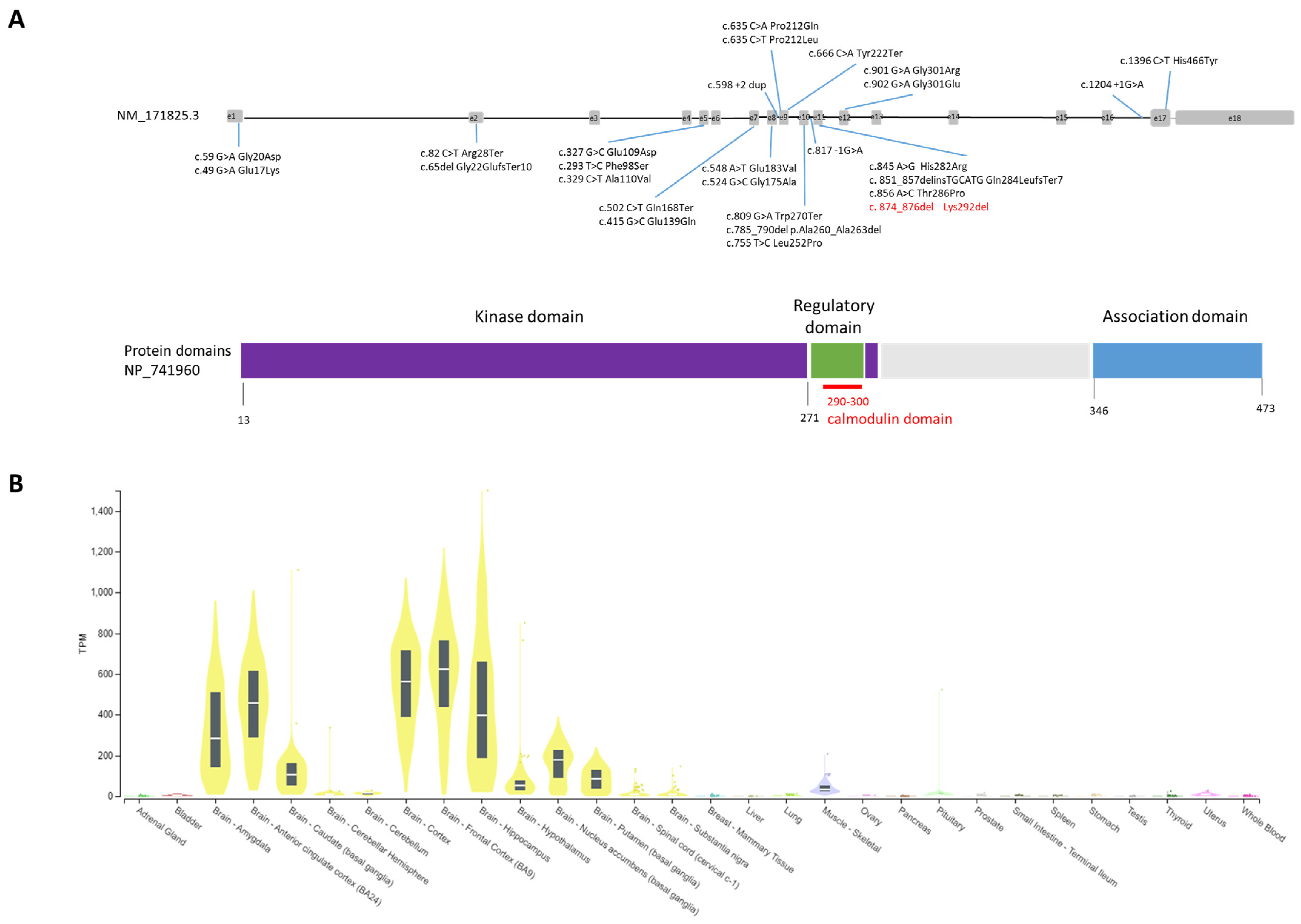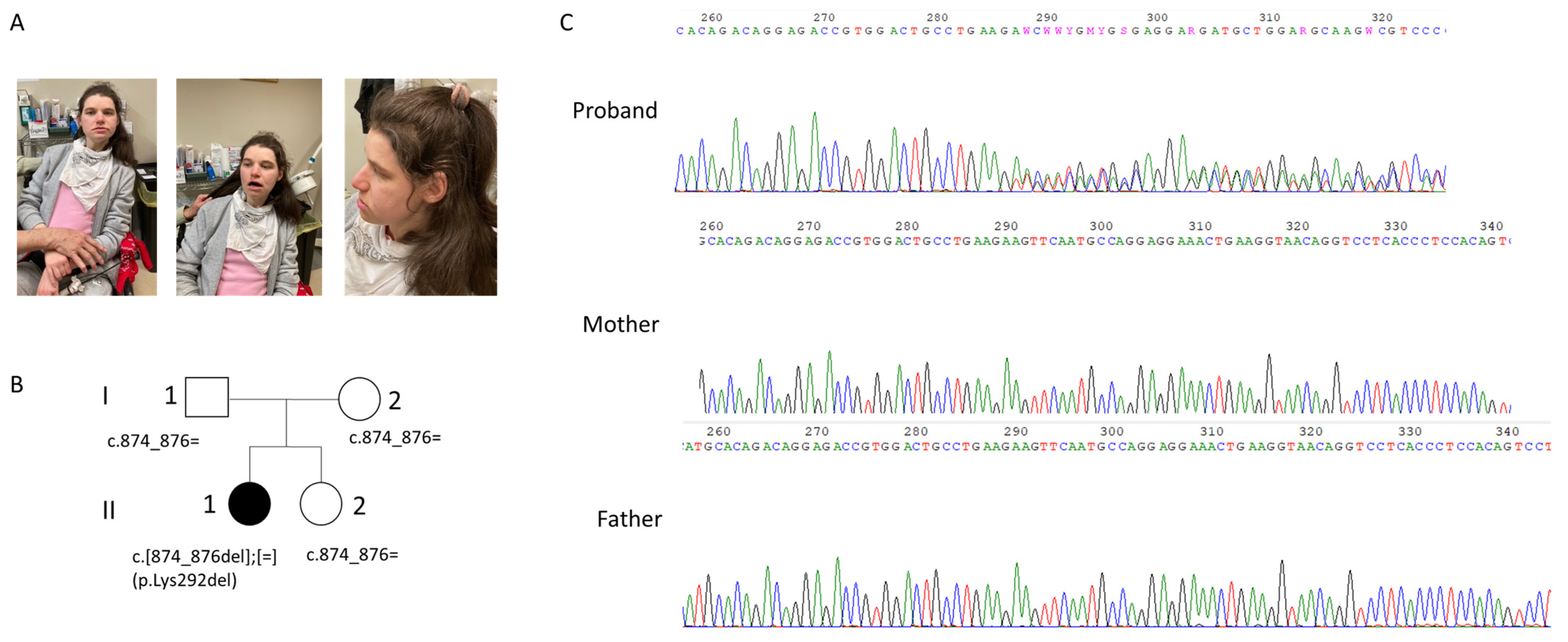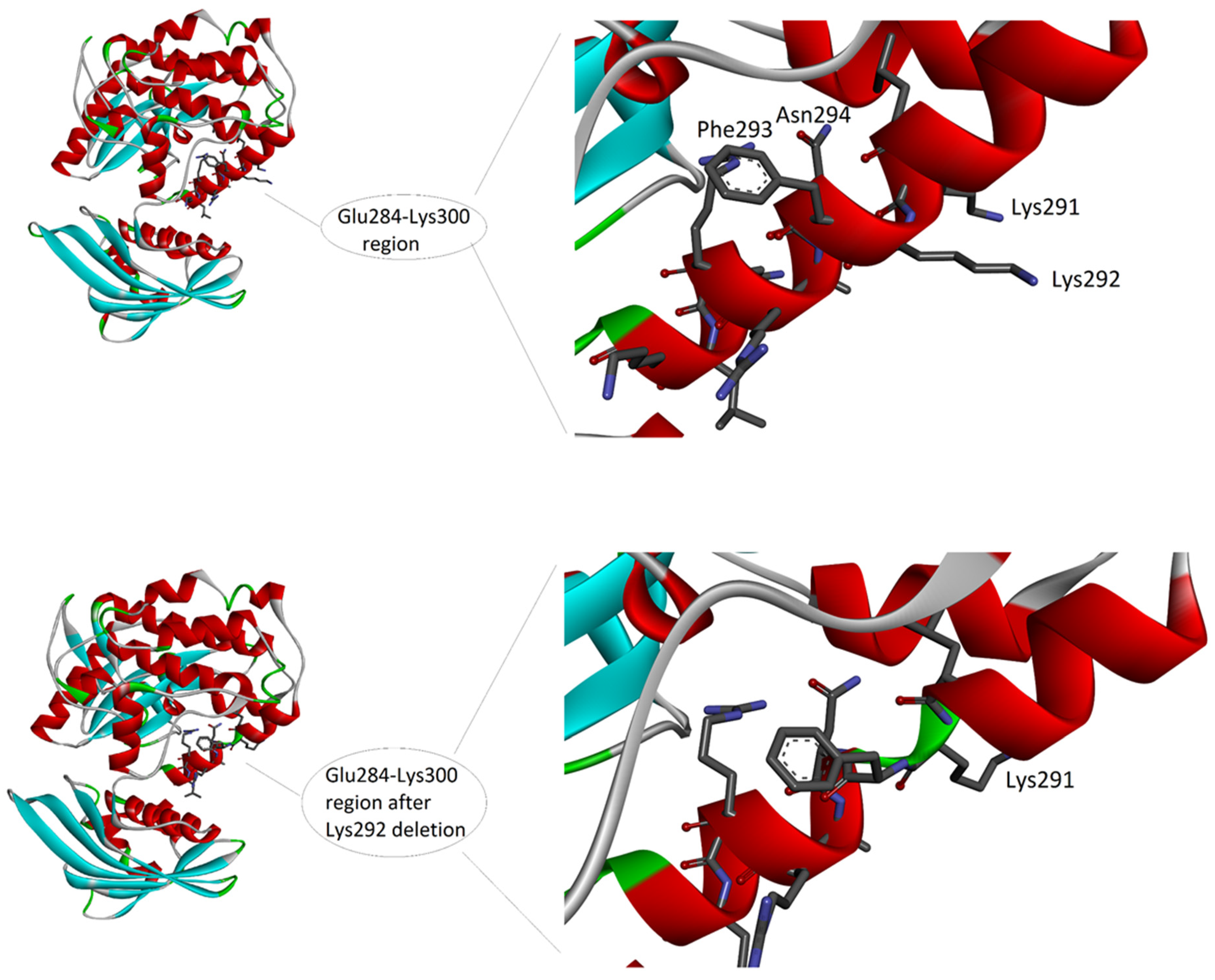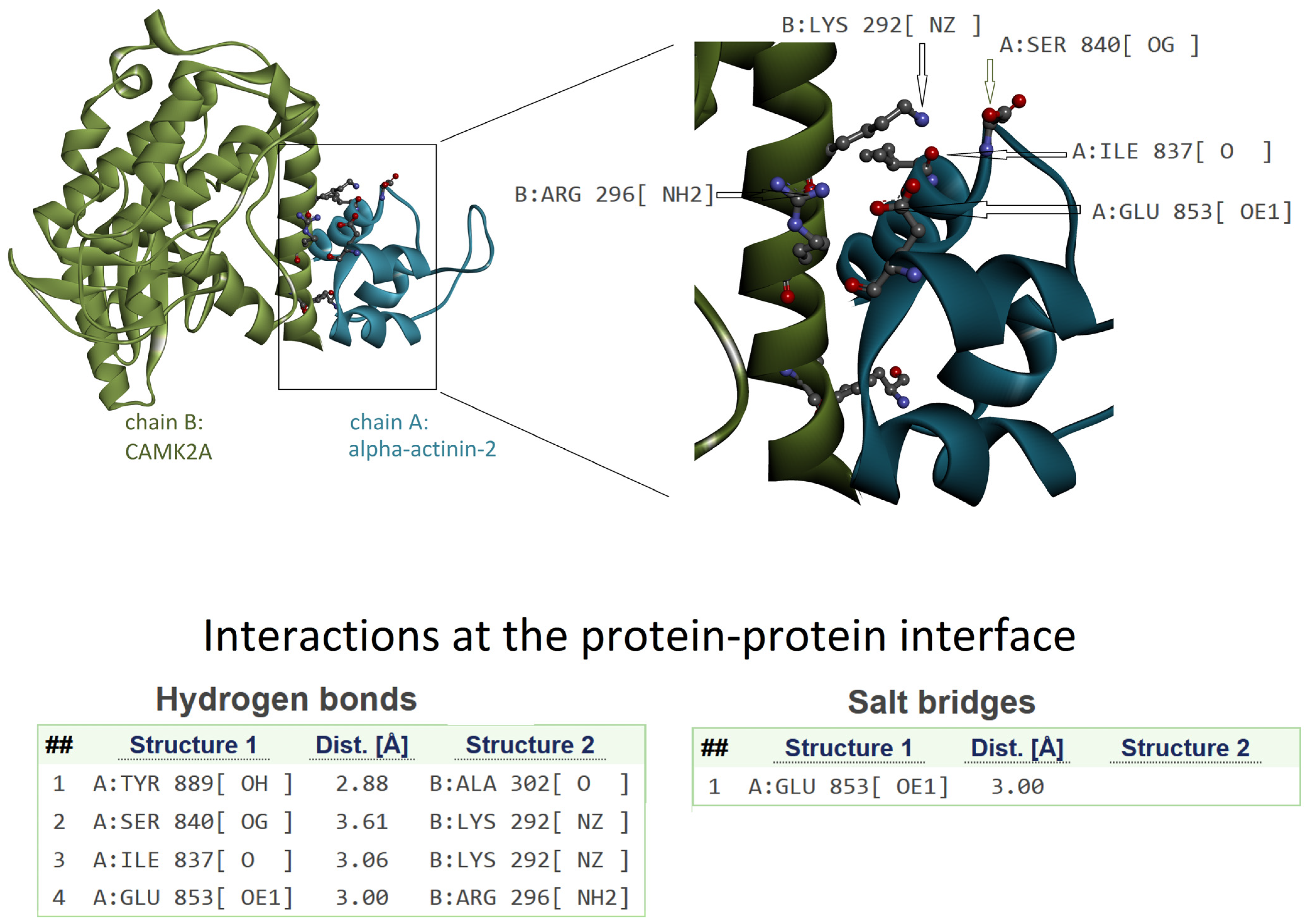Deletion of a Single Lysine Residue at Position 292 of CAMK2A Disrupts Protein Function, Causing Severe Epileptic Encephalopathy and Intellectual Disability
Abstract
1. Introduction
2. Materials and Methods
2.1. DNA Extraction and Exome Sequencing
2.2. Sanger Sequencing
2.3. Protein Modelling and Structural Analysis
3. Results
3.1. Clinical Description of the Proband
3.2. Genetic Findings
3.3. Protein Structure
4. Discussion
Author Contributions
Funding
Institutional Review Board Statement
Informed Consent Statement
Data Availability Statement
Acknowledgments
Conflicts of Interest
References
- Stephenson, J.R.; Wang, X.; Perfitt, T.L.; Parrish, W.P.; Shonesy, B.C.; Marks, C.R.; Mortlock, D.P.; Nakagawa, T.; Sutcliffe, J.S.; Colbran, R.J. A Novel Human CAMK2A Mutation Disrupts Dendritic Morphology and Synaptic Transmission, and Causes ASD-Related Behaviors. J. Neurosci. 2017, 37, 2216–2233. [Google Scholar] [CrossRef]
- Küry, S.; van Woerden, G.M.; Besnard, T.; Proietti Onori, M.; Latypova, X.; Towne, M.C.; Cho, M.T.; Prescott, T.E.; Ploeg, M.A.; Sanders, S.; et al. De Novo Mutations in Protein Kinase Genes CAMK2A and CAMK2B Cause Intellectual Disability. Am. J. Hum. Genet. 2017, 101, 768–788. [Google Scholar] [CrossRef]
- Chia, P.H.; Zhong, F.L.; Niwa, S.; Bonnard, C.; Utami, K.H.; Zeng, R.; Lee, H.; Eskin, A.; Nelson, S.F.; Xie, W.H.; et al. A homozygous loss-of-function CAMK2A mutation causes growth delay, frequent seizures and severe intellectual disability. Elife 2018, 7, e32451. [Google Scholar] [CrossRef]
- Lisman, J.; Yasuda, R.; Raghavachari, S. Mechanisms of CaMKII action in long-term potentiation. Nat. Rev. Neurosci. 2012, 13, 169–182. [Google Scholar] [CrossRef] [PubMed]
- Hell, J.W. CaMKII: Claiming center stage in postsynaptic function and organization. Neuron 2014, 81, 249–265. [Google Scholar] [CrossRef] [PubMed]
- Goecks, J.; Nekrutenko, A.; Taylor, J.; Galaxy Team. Galaxy: A comprehensive approach for supporting accessible, reproducible, and transparent computational research in the life sciences. Genome Biol. 2010, 11, R86. [Google Scholar] [CrossRef]
- Li, H.; Durbin, R. Fast and accurate short read alignment with burrows-wheeler transform. Bioinformatics 2009, 25, 1754–1760. [Google Scholar] [CrossRef]
- Yang, H.; Wang, K. Genomic variant annotation and prioritization with ANNOVAR and wANNOVAR. Nat. Protoc. 2015, 10, 1556–1566. [Google Scholar] [CrossRef]
- DePristo, M.A.; Banks, E.; Poplin, R.; Garimella, K.V.; Maguire, J.R.; Hartl, C.; Philippakis, A.A.; del Angel, G.; Rivas, M.A.; Hanna, M.; et al. A framework for variation discovery and genotyping using next-generation DNA sequencing data. Nat. Genet. 2011, 43, 491–498. [Google Scholar] [CrossRef] [PubMed]
- Van der Auwera, G.A.; Carneiro, M.O.; Hartl, C.; Poplin, R.; Del Angel, G.; Levy-Moonshine, A.; Jordan, T.; Shakir, K.; Roazen, D.; Thibault, J.; et al. From FastQ data to high confidence variant calls: The Genome Analysis Toolkit best practices pipeline. Curr. Protoc. Bioinform. 2013, 43, 11.10.1–11.10.33. [Google Scholar] [CrossRef] [PubMed]
- Richards, S.; Aziz, N.; Bale, S.; Bick, D.; Das, S.; Gastier-Foster, J.; Grody, W.W.; Hegde, M.; Lyon, E.; Spector, E.; et al. Standards and guidelines for the interpretation of sequence variants: A joint consensus recommendation of the American College of Medical Genetics and Genomics and the Association for Molecular Pathology. Genet. Med. 2015, 17, 405–424. [Google Scholar] [CrossRef]
- Marabotti, A.; D’Auria, S.; Rossi, M.; Facchiano, A.M. Theoretical model of the three-dimensional structure of a sugar-binding protein from Pyrococcus horikoshii: Structural analysis and sugar-binding simulations. Biochem. J. 2004, 380, 677–684. [Google Scholar] [CrossRef] [PubMed]
- Buonocore, F.; Stocchi, V.; Nunez-Ortiz, N.; Randelli, E.; Gerdol, M.; Pallavicini, A.; Facchiano, A.; Bernini, C.; Guerra, L.; Scapigliati, G.; et al. Immunoglobulin T from sea bass (Dicentrarchus labrax L.): Molecular characterization, tissue localization and expression after nodavirus infection. BMC Mol. Biol. 2017, 1, 8. [Google Scholar] [CrossRef] [PubMed]
- Šali, A.; Blundell, T.L. Comparative protein modelling by satisfaction of spatial restraints. J. Mol. Biol. 1993, 234, 779–815. [Google Scholar] [CrossRef]
- Krissinel, E.; Henrick, K. Inference of macromolecular assemblies from crystalline state. J. Mol. Biol. 2007, 372, 774–797. [Google Scholar] [CrossRef]
- André, I.; Kesvatera, T.; Jönsson, B.; Akerfeldt, K.S.; Linse, S. The role of electrostatic interactions in calmodulin-peptide complex formation. Biophys. J. 2004, 87, 1929–1938. [Google Scholar] [CrossRef]
- Silva, A.J.; Wang, Y.; Paylor, R.; Wehner, J.M.; Stevens, C.F.; Tonegawa, S. α calcium/calmodulin kinase II mutant mice: Deficient long-term potentiation and impaired spatial learning. Cold Spring Harb. Symp. Quant. Biol. 1992, 57, 527–539. [Google Scholar] [CrossRef]
- Silva, A.J.; Paylor, R.; Wehner, J.M.; Tonegawa, S. Impaired spatial learning in α-calcium-calmodulin kinase II mutant mice. Science 1992, 257, 206–211. [Google Scholar] [CrossRef]
- Chen, C.; Rainnie, D.G.; Greene, R.W.; Tonegawa, S. Abnormal fear response and aggressive behavior in mutant mice deficient for α-calcium-calmodulin kinase II. Science 1994, 266, 291–294. [Google Scholar] [CrossRef] [PubMed]
- Akita, T.; Aoto, K.; Kato, M.; Shiina, M.; Mutoh, H.; Nakashima, M.; Kuki, I.; Okazaki, S.; Magara, S.; Shiihara, T.; et al. De novo variants in CAMK2A and CAMK2B cause neurodevelopmental disorders. Ann. Clin. Transl. Neurol. 2018, 5, 280–296. [Google Scholar] [CrossRef]
- Rigter, P.M.F.; Wallaard, I.; Aghadavoud Jolfaei, M.; Kingma, J.; Post, L.; Elgersma, M.; Elgersma, Y.; van Woerden, G.M. Adult Camk2a gene reinstatement restores the learning and plasticity deficits of Camk2a knockout mice. Iscience 2022, 25, 105303. [Google Scholar] [CrossRef] [PubMed]




| Patient | Variant | Type of Variant | ID | Seizure | Microcephaly | Language | Hypotonia | Affected Domain | Ref. |
|---|---|---|---|---|---|---|---|---|---|
| 1 | Pro212Gln | Missense | Severe | Yes | Yes | Not verbal | Yes | Kinase domain | [20] |
| 2 | Pro235Leu | Missense | Severe | Yes | No | Not verbal | Not specified | Kinase domain | [20] |
| 3 | c.817 − 1G > A | Splicing | Severe | Yes | No | Not specified | Yes | Regulatory domain | [20] |
| 4 | Gly22Glufs*10 | Frameshift | Moderate | No | No | Delayed speech | No | Kinase domain | [2] |
| 5 | Phe98Ser | Missense | Moderate | No | No | Delayed speech | Yes | Kinase domain | [2] |
| 6 | Glu109Asp | Missense | Severe | Yes | No | Delayed speech | Yes | Kinase domain | [2] |
| 7 | Ala112Val | Missense | Severe | No | No | Delayed speech | Yes | Kinase domain | [2] |
| 8 | Glu183Val | Missense | Mild | No | No | Delayed speech | No | Kinase domain | [2] |
| 9 | c.598 + 2dup | Missense | Severe | No | No | Delayed speech | No | Not reported | [2] |
| 10 | Pro212Leu | Missense | Severe | Yes | No | Delayed speech | Yes | Kinase domain | [2] |
| 11 | Pro212Leu | Missense | Mild-severe | Yes | Yes | Delayed speech | Yes | Kinase domain | [2] |
| 12 | Pro212Leu | Missense | Moderate | No | No | Delayed speech | No | Kinase domain | [2] |
| 13 | Pro235Leu | Missense | Mild | No | No | Delayed speech | No | Kinase domain | [2] |
| 14 | c.817 − 1G > A | Splicing | Severe | Yes | No | Delayed speech | Yes | Not reported | [2] |
| 15 | His282Arg | Missense | Severe | No | No | Delayed speech | No | Regulatory domain | [2] |
| 16 | Thr286Pro | Missense | Severe | No | No | Delayed speech | Yes | Regulatory domain | [2] |
| 17 | c.1204 + 1G > A | Splicing | Mild | No | No | No | No | Not reported | [2] |
| 18 | c.874_876delCTT, p. Lys292del | Inframe deletion | Severe | Yes | Yes | Not verbal | Yes | Regulatory domain | Our patient |
Disclaimer/Publisher’s Note: The statements, opinions and data contained in all publications are solely those of the individual author(s) and contributor(s) and not of MDPI and/or the editor(s). MDPI and/or the editor(s) disclaim responsibility for any injury to people or property resulting from any ideas, methods, instructions or products referred to in the content. |
© 2023 by the authors. Licensee MDPI, Basel, Switzerland. This article is an open access article distributed under the terms and conditions of the Creative Commons Attribution (CC BY) license (https://creativecommons.org/licenses/by/4.0/).
Share and Cite
Lintas, C.; Facchiano, A.; Azzarà, A.; Cassano, I.; Tabolacci, C.; Galasso, C.; Gurrieri, F. Deletion of a Single Lysine Residue at Position 292 of CAMK2A Disrupts Protein Function, Causing Severe Epileptic Encephalopathy and Intellectual Disability. Genes 2023, 14, 1353. https://doi.org/10.3390/genes14071353
Lintas C, Facchiano A, Azzarà A, Cassano I, Tabolacci C, Galasso C, Gurrieri F. Deletion of a Single Lysine Residue at Position 292 of CAMK2A Disrupts Protein Function, Causing Severe Epileptic Encephalopathy and Intellectual Disability. Genes. 2023; 14(7):1353. https://doi.org/10.3390/genes14071353
Chicago/Turabian StyleLintas, Carla, Angelo Facchiano, Alessia Azzarà, Ilaria Cassano, Claudio Tabolacci, Cinzia Galasso, and Fiorella Gurrieri. 2023. "Deletion of a Single Lysine Residue at Position 292 of CAMK2A Disrupts Protein Function, Causing Severe Epileptic Encephalopathy and Intellectual Disability" Genes 14, no. 7: 1353. https://doi.org/10.3390/genes14071353
APA StyleLintas, C., Facchiano, A., Azzarà, A., Cassano, I., Tabolacci, C., Galasso, C., & Gurrieri, F. (2023). Deletion of a Single Lysine Residue at Position 292 of CAMK2A Disrupts Protein Function, Causing Severe Epileptic Encephalopathy and Intellectual Disability. Genes, 14(7), 1353. https://doi.org/10.3390/genes14071353







